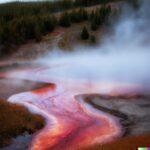If you’re a fan of natural wonders and geological marvels, then the Norris Geyser Basin is a destination you won’t want to miss. Located in Yellowstone National Park, this unique thermal area is home to a variety of geysers, hot springs, and colorful pools that will leave you in awe.
In this article, we’ll explore the formation, features, significance, and safety tips of the Norris Geyser Basin, as well as the best time to visit and nearby attractions to check out. So, get ready to embark on a journey through one of nature’s most fascinating creations.
What is the Norris Geyser Basin?
The Norris Geyser Basin, located in Yellowstone National Park, is a remarkable geothermal area known for its diverse geologic features and intense thermal activity.
Visitors to the Norris Geyser Basin are mesmerized by the array of geysers, hot springs, and unique geological formations that abound in this natural wonderland. The basin boasts some of the hottest and most acidic geothermal features in the park, attracting scientists from around the world to conduct in-depth research on the underlying geology and hydrothermal processes.
The geysers, such as Steamboat Geyser, the world’s tallest active geyser, spout scalding water with impressive force, while the kaleidoscope of colorful hot springs showcases the delicate balance of microbial life thriving in extreme conditions.
Where is the Norris Geyser Basin located?
The Norris Geyser Basin is situated within the boundaries of Yellowstone National Park, a UNESCO World Heritage Site, and it is characterized by its volcanic origins and hydrothermal features.
Located in the northwest region of Yellowstone National Park, the Norris Geyser Basin stands out for its unique geological features shaped by the powerful forces within the Earth’s crust. The thermal activity in the area is fueled by a combination of heat sources, including the presence of a magmatic heat source at a depth and a shallow hydrothermal reservoir. These elements contribute to the dynamic nature of the geysers, hot springs, fumaroles, and mud pots that make up this fascinating landscape.
How was the Norris Geyser Basin formed?
The Norris Geyser Basin was formed through a complex interplay of geological processes involving a magma chamber deep underground, a hydrothermal system, and the continuous cycling of water through the geothermal features.
The magma chamber beneath the surface of the Norris Geyser Basin plays a crucial role in providing the intense heat needed for the geothermal activity to occur. As magma heats up the surrounding rocks and groundwater, pressure builds, eventually leading to the release of steam and hot water through the various geysers and hot springs in the area. This hydrothermal system acts as a conduit for the transfer of heat and minerals to the surface, creating the diverse array of geothermal features that define the basin’s unique landscape.
The water cycle within the basin is vital to sustaining these geothermal processes, as water seeps into the ground, gets heated by the magma chamber, rises back to the surface, and then repeats the cycle, perpetuating the geothermal activity.
What are the main features of the Norris Geyser Basin?
The Norris Geyser Basin showcases a diverse range of geothermal features, including spectacular geysers, bubbling hot springs, hissing steam vents, noxious fumaroles, and colorful mud pots.
The geysers in the Norris Geyser Basin are a mesmerizing natural phenomenon, shooting hot water and steam high into the air at regular intervals, creating a dramatic spectacle for visitors. These geysers, such as Steamboat Geyser and Echinus Geyser, are some of the largest and most powerful in the world.
Hot springs, on the other hand, are serene pools of mineral-rich water that maintain a consistently warm temperature, providing a stark contrast to the eruptive geysers. The steam vents release streams of vapor into the air, resembling ethereal clouds, while fumaroles emit sulfurous gases with a characteristic hissing sound, reminding visitors of the active volcanic processes beneath the Earth’s surface. The mud pots, with their bubbling, boiling mud that paints the landscape in vibrant hues, showcase the dynamic and ever-changing nature of the geothermal activity in the area.
Each of these features contributes to the unique geothermal landscape of Norris Geyser Basin, offering a glimpse into the powerful forces at work in the depths of the Earth.
Steamboat Geyser
The Steamboat Geyser, one of the main attractions in the Norris Geyser Basin, is renowned for its towering eruptions that exemplify the powerful geological processes at work beneath the surface.
These eruptions can reach heights of over 300 feet, making Steamboat Geyser the world’s tallest currently active geyser. What sets Steamboat apart is its unpredictability, sometimes remaining dormant for years before suddenly erupting with tremendous force. The geological mechanism behind this phenomenon involves a combination of superheated water and underground volcanic activity, creating a pressure build-up that eventually culminates in these awe-inspiring displays.
Visitors are captivated by the raw power and beauty of Steamboat Geyser, a natural wonder that reminds us of Earth’s dynamic, ever-changing nature.
Echinus Geyser
The Echinus Geyser in the Norris Geyser Basin captivates visitors with its rhythmic eruptions and colorful pool, offering a glimpse into the dynamic hydrothermal activity prevalent in the area.
The geyser’s eruptions, characterized by bursts of water shooting as high as 60 feet into the air, create a mesmerizing spectacle that showcases the intense geological forces at play. Its unique feature lies in the vibrant hues of its pool, a result of thermophilic microorganisms thriving in the scalding waters. These organisms contribute to the ecosystem of the geyser, highlighting the interconnectedness of life and geothermal processes. The sustained thermal activity of Echinus Geyser underscores its importance in maintaining the geothermal landscape, perpetuating a delicate balance of natural elements.
Porcelain Basin
Porcelain Basin, a section of the Norris Geyser Basin, offers visitors a surreal landscape adorned with intricate geothermal features and vibrant thermal activity that showcase the area’s geological richness.
Wandering along the boardwalks in Porcelain Basin, one can witness the mesmerizing display of bubbling hot springs, erupting geysers, and colorful microbial mats decorating the area. The symphony of hissing steam vents and gurgling mud pots creates an otherworldly atmosphere that underscores the relentless thermal processes shaping this unique environment.
The juxtaposition of the stark white silica formations against the vivid hues of the thermal pools creates a visual feast for nature enthusiasts and photographers alike.
Back Basin
Back Basin, a prominent area within the Norris Geyser Basin, entices visitors with a mesmerizing array of geysers, hot springs, and an intricate hydrothermal system that exemplify the area’s geothermal allure.
Stepping into Back Basin is like stepping into a world where nature’s forces are on full display. The geysers here, such as the renowned Steamboat Geyser, shoot jets of boiling water high into the sky, creating a spectacle unlike any other. The colorful hot springs dotting the landscape add a vibrant contrast to the steaming vents and bubbling mudpots. As you explore the area, you can feel the earth’s power beneath your feet, a reminder of the region’s geological significance and the ongoing processes that shape this unique environment.
Emerald Spring
Emerald Spring, a stunning hot spring in the Norris Geyser Basin, harbors a unique ecosystem teeming with vibrant microbial life that thrives in the scalding waters, creating a mesmerizing natural spectacle.
These extremophilic microorganisms have adapted to survive in the extreme temperatures and acidic conditions of the hot spring, showcasing the remarkable resilience of life on Earth. The thermal features of Emerald Spring provide a glimpse into the resilience and adaptability of life forms in harsh environments, offering important insights into the limits of habitability for life.
The diversity of microbial communities in hot springs like Emerald Spring plays a crucial role in nutrient cycling and biochemistry, contributing to the overall health and balance of the ecosystem. By understanding these intricate relationships, scientists can gain valuable knowledge about how life thrives in extreme conditions.
What is the significance of the Norris Geyser Basin?
The Norris Geyser Basin holds immense significance for scientific research, offering insights into ground deformation, seismic activity, and the harnessing of geothermal energy for sustainable applications.
Researchers are drawn to the basin for its unique geologic features that provide opportunities to study how the Earth’s crust responds to tectonic forces. By monitoring ground deformation and seismic activity in real-time, scientists can gain a better understanding of the underlying processes that drive volcanic activity and geothermal energy potential. The data collected from the basin contributes to advancing geothermal energy technologies, paving the way for increased utilization of clean and renewable energy sources.
Studying the Norris Geyser Basin opens up possibilities for innovative research that could shape the future of sustainable energy development.
What is the best time to visit the Norris Geyser Basin?
The best time to visit the Norris Geyser Basin is during the shoulder seasons of spring and fall when the weather is milder, and the crowds are smaller, allowing for a more intimate experience with the geothermal wonders.
During spring, the vibrant blooms of wildflowers paint the landscape with breathtaking hues, enhancing the picturesque views of the geysers and hot springs. The cooler temperatures make hiking and exploring the trails more enjoyable, without the scorching heat of summer.
Fall brings a stunning display of autumn colors, adding a striking contrast to the geothermal features. The crisp air and peaceful ambiance further enchant visitors, providing a serene setting to admire the unique geological formations at Norris Geyser Basin.
What are the safety precautions to take when visiting the Norris Geyser Basin?
When visiting the Norris Geyser Basin, it is essential to adhere to safety precautions due to the presence of geothermal hazards such as scalding water, unstable ground, and toxic gases.
To ensure a safe and enjoyable experience, visitors should remain on marked trails to avoid venturing into hazardous areas. Paying close attention to warning signs and staying vigilant can prevent accidents. It is crucial to respect the natural environment and keep a safe distance from the geothermal features to prevent any injuries or damage. Being aware of potential risks and following these guidelines will contribute to a memorable and secure visit to the Norris Geyser Basin.
How can visitors access the Norris Geyser Basin?
Visitors can access the Norris Geyser Basin by car through the park’s main roads, with designated parking areas available near the basin’s entrance, and explore the area via well-maintained trails starting from the visitor center.
From the visitor center, hikers can embark on various trails that wind through the geothermal wonders of the basin, guiding them to vibrant hot springs, bubbling mud pots, and iconic geysers like Steamboat Geyser.
Shuttle services are also available for those who prefer not to drive, providing convenient access to the basin’s marvels. The parking facilities cater to both individual vehicles and tour buses, ensuring that visitors have ample options for safe and easy transportation to explore the unique features of Norris Geyser Basin.
What are the nearby attractions to the Norris Geyser Basin?
In close proximity to the Norris Geyser Basin are captivating attractions like Mammoth Hot Springs, Grand Prismatic Spring, the iconic Old Faithful Geyser, and the serene Yellowstone Lake, each offering a unique natural spectacle to visitors.
-
Mammoth Hot Springs, with its terraces of crystallized calcium carbonate cascading down the hillside, create a stunning visual display that changes with the flow of hot water.
-
Grand Prismatic Spring, known for its vibrant colors and large size, is a must-see wonder.
-
The famous Old Faithful Geyser, erupting predictably every 60-90 minutes, never fails to awe spectators.
-
Yellowstone Lake, the largest high-elevation lake in North America, invites visitors to enjoy boating, fishing, and breathtaking views of the surrounding mountains and forests.
Mammoth Hot Springs
Mammoth Hot Springs, located near the Norris Geyser Basin, boasts stunning travertine terraces formed by the interaction of hot water with limestone, creating a surreal landscape of cascading mineral formations.
The intricate process of travertine terrace formation at Mammoth Hot Springs begins with the hot water rising through the earth’s crust, carrying dissolved calcium carbonate. As the hot water reaches the surface and evaporates, it leaves behind deposits of this mineral, gradually building up the terraces over time.
The varying temperatures and mineral compositions in the geothermal springs contribute to the vibrant colors seen in the terraces, ranging from brilliant whites to rich oranges and reds. Visitors can witness the ever-changing beauty of Mammoth Hot Springs as the geothermal activity continues to shape and reshape this enchanting natural wonder.
Grand Prismatic Spring
The Grand Prismatic Spring, a short distance from the Norris Geyser Basin, mesmerizes visitors with its brilliant colors, intricate microbial mats, and expansive size, making it a must-see attraction in Yellowstone.
The vivid colors of the Grand Prismatic Spring are a result of the various pigmented bacteria that thrive in the different temperature zones of the spring, creating a breathtaking palette that ranges from vibrant blues to deep oranges. These microbial communities, with their unique adaptations to extreme environments, have fascinated scientists and visitors alike, offering a fascinating glimpse into the intricate web of life that exists within this geological wonder.
Old Faithful Geyser
The Old Faithful Geyser, a legendary icon of Yellowstone National Park near the Norris Geyser Basin, delights spectators with its regular and predictable eruptions, offering a timeless display of nature’s power.
This natural wonder has been captivating visitors for decades, drawing people from all corners of the globe to witness its majestic displays. Its eruptions, which can reach heights of up to 180 feet, occur roughly every 60 to 90 minutes, making it one of the most predictable geysers in the world. The Old Faithful Geyser holds immense cultural significance, symbolizing the untamed beauty and awe-inspiring forces of the park’s geothermal features, becoming a symbol of Yellowstone’s geological wonders.
Yellowstone Lake
Yellowstone Lake, in proximity to the Norris Geyser Basin, stands as the largest high-elevation lake in North America, offering scenic vistas, tranquil waters, and abundant recreational opportunities for park visitors.
The vast expanse of Yellowstone Lake spans over 130 square miles, surrounded by pristine forests and snow-capped peaks that create a breathtaking backdrop.
Visitors can enjoy a variety of activities such as fishing for native cutthroat trout, kayaking or paddleboarding on the crystal-clear waters, or simply relaxing on the beaches and taking in the awe-inspiring views.
Hiking trails along the lake provide opportunities to observe diverse wildlife, including bald eagles soaring overhead and elk grazing along the shoreline. It’s truly a nature lover’s paradise waiting to be explored.
Last Updated on February 11, 2024 by Jon Waraas – Originally Posted: February 11, 2024

I’m Jon Waraas, and I’ve been navigating the online world since 2006. By day, I’m the proud owner of some eCommerce gems, and by night, I’m the voice behind the adventures on Waraas.Com.
My heart, however, belongs to the wild beauty of Yellowstone National Park. I’ve got a collection of websites dedicated to sharing the wonders of this natural masterpiece. Oh, and did I mention? I’m currently building my own cabin inside the ghost town of Gilmore, Idaho – a cabin with tales to tell!
When I’m not immersed in the digital realm, you’ll find me lacing up my boots for a good hike or setting up camp under the star-studded sky.




